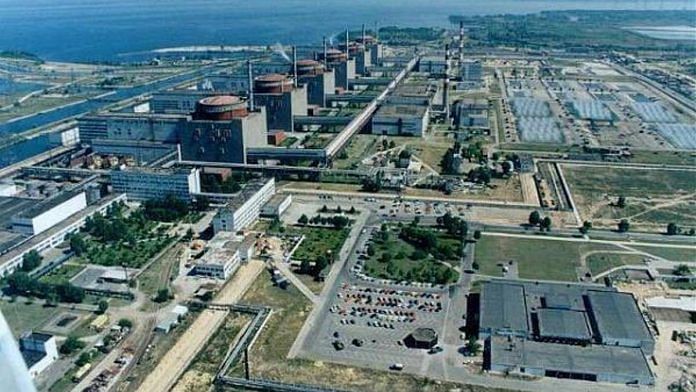New Delhi: Shelling at Ukraine’s Zaporizhzhia nuclear plant by Russian forces early Friday morning has raised the spectre of a nuclear catastrophe.
Moreover, it brings back to mind the havoc wreaked by previous nuclear meltdowns, most horribly at Chernobyl in 1986.
Due to the shelling, a fire broke out at one of the training facilities near the Zaporizhzhia plant. Ukraine’s energy minister, Herman Halushchenko, stated that initially Ukrainian authorities were blocked from controlling the fire, but later they were allowed to douse it.
Knowing the dire consequences of uncontrolled nuclear radiation, news of the fire rang alarm bells across Europe.
Ukraine’s foreign minister, Dmytro Kuleba, even tweeted that spill-overs could be ten times worse than Chernobyl.
Later in the morning, local Ukrainian authorities confirmed that radiation levels had remained normal. Reports later confirmed that Russia had taken control of the plant.
Also read: China’s nuclear leak is no Chernobyl, but how it was handled is troubling
What happened at Chernobyl
With Russia pursuing a strategy of pounding Ukrainian cities with artillery and missile barrages, aiming at vital infrastructure, Ukraine’s four nuclear plants pose even bigger risks in the current conflict.
As the meltdown at the Chernobyl plant showed the world, the effects of nuclear spillovers can be perilous and long-term.
In 1986, a sudden increase in voltage levels during a routine reactor test destroyed unit 4 of the nuclear power station at Chernobyl. This led to a fire and several blasts, which resulted in massive amounts of radioactive material being released from the plant.
Nearly 2,00,000 people were evacuated because of the accident. The radioactive spillovers stretched nearly 1,50,000 square kilometres from the site. An area with a 30-kilometre radius around the plant is considered an exclusion zone and uninhabited even today.
While official estimates state that 31 people had died as a result of the accident, in 2005 the UN predicted that nearly 4,000 people might die in the long term due to radiation exposure.
How does a nuclear meltdown take place?
Nuclear meltdowns take place when the reactor — the instrument creating energy in a nuclear power plant — or the storage facility where the reactor is kept, is damaged.
Any such damage to the reactor or the storage facility can lead to inconsistencies in the electricity supply that controls the water flow. This flow maintains the equilibrium temperature while nuclear fission and fusion take place during energy generation. Irregularities with the water supply can then cause the reactor to overheat and a meltdown to take place.
Differences between Chernobyl and Zaporizhzhia
Reports suggest that the Zaporizhzhia plant is far more secure than the Chernobyl plant.
The reactors at Zaporizhzhia have emergency core cooling systems and enhanced injection mechanisms to offset the core from melting. The reactors at Zaporizhzhia are also supposed to be protected by robust containment structures. These reactors are also pressurised water reactors, unlike the ones at Chernobyl.
Significantly, unlike Chernobyl, the Zaporizhzhia reactors do not contain graphite. Graphite intensely enhanced the fire at Chernobyl and was a catalyst to the dissemination of the radioactive material.
While the situation in Zaporizhzhia is completely different to Chernobyl — the latter was an accident and the former a risk posed by intentional shelling — the fraught situation makes it essential to learn from the events of 1986.
Even though the fire at Zaporizhzhia has been doused and was at a training building near the plant, if the fire had spread to the reactors, the complications could have been immense.
This is because the fuel in these reactors is more radioactive than it was at Chernobyl.
More significantly, though only one of the six reactors was functional before Russia took over the Zaporizhzhia plant, all the six reactors would need to cool down to prevent a meltdown and further explosions, as transpired in Fukushima in Japan in 2011.
As explained, the electricity supply is essential for this process of cooling and a fire could have disconnected this supply, leading to possible explosions.
However, the silver lining is that any chances of explosion, meltdown or spread of radioactive material look unlikely, as the International Atomic Energy Agency (IAEA) tweeted that “essential equipment” had not been affected.
Russia’s takeover of the plant is significant, as it could have negative effects on Ukraine’s energy supplies.
The Zaporizhzhia plant accounts for nearly 20 per cent of the country’s electricity. Ukraine’s four nuclear plants together generate nearly half the country’s electricity, perhaps explaining Russia’s thinking behind this hazardous strategy of targeting the plant.
(Edited by Saikat Niyogi)
Also read: Day after seizing Chernobyl nuclear plant, Russia claims personnel working at the facility as usual



